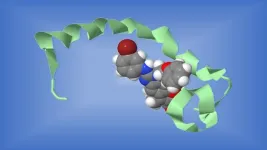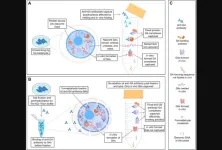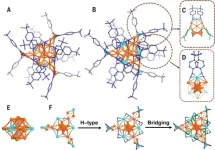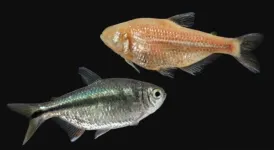(Press-News.org) Two progressively degenerative diseases, amyotrophic lateral sclerosis (ALS, commonly known as Lou Gehrig’s disease) and frontotemporal dementia (FTD, recently in the news with the diagnoses of actor Bruce Willis and talk show host Wendy Williams), are linked by more than the fact that they both damage nerve cells critical to normal functioning — the former affecting nerves in the brain and spinal cord leading to loss of movement, the latter eroding the brain regions controlling personality, behavior and language.
Research studies have repeatedly shown that in patients with ALS or FTD, the function of TAR DNA-binding protein 43, more commonly called TDP-43, becomes corrupted. When this happens, pieces of the genetic material called ribonucleic acid (RNA) can no longer be properly spliced together to form the coded instructions needed to direct the manufacture of other proteins required for healthy nerve growth and function. The RNA strands become riddled with erroneous code sequences called “cryptic exons” that instead affect proteins believed to be associated with increased risk for ALS and FTD development.
Until now, it was unknown if this abnormality occurred early or late in the clinical courses of ALS and FTD. In a study in the February 2024 issue of the journal Nature Medicine (first posted online Jan. 25, 2024),Johns Hopkins Medicine researchers tell how they answered that long-pondered question.
“We developed a method for locating a specific cryptic exon-linked protein, hepatoma-derived growth factor-like 2 [HDGFL2], that is associated with the loss of TDP-43’s function,” says senior study author Philip Wong, Ph.D., professor of pathology and neuroscience at the Johns Hopkins University School of Medicine. “By doing so, we believe we’ve discovered a biomarker that could potentially be used to detect ALS and FTD in their earliest stages — even before symptoms appear.”
The hunt for the biomarker began with the researchers first identifying cryptic exon-linked proteins associated with TDP-43 function loss. Then, using fragments from those proteins known as cryptic peptides, they created monoclonal (laboratory-made) antibodies specific to each one. Placed into patient samples of blood or cerebrospinal fluid (the protective fluid that surrounds the brain and central nervous system), the monoclonal antibodies will seek and lock onto only the cryptic peptides for which they were designed, making those proteins detectable.
“Of all the cryptic peptides for which we made monoclonal antibodies, the one that worked best was the one designed for the cryptic HDGFL2 protein,” says study lead author Katie Irwin, an M.D./Ph.D. student at the Johns Hopkins University School of Medicine. “We used that monoclonal antibody to develop an extremely sensitive detection test for the cryptic HDGFL2 protein in body fluids.”
After validating their detection method in the lab, the researchers used it to test blood and cerebrospinal fluid samples from three different collections, encompassing people with the most common forms of familial (genetic) ALS and FTD linked to a mutation in the C9orf72 gene, sporadic (not defined as genetic) forms of ALS and FTD, and healthy controls. The collections also contained biofluid samples from patients with ALS and FTD prior to their diagnoses, meaning that the researchers could look for cryptic HDGFL2 at both presymptomatic and symptomatic stages of the diseases.
“Our test found cryptic HDGFL2 in the presymptomatic stages of patients who were genetically predisposed to ALS and FTD, and were expected to go on to develop the diseases, giving the method credibility as a potential preclinical biomarker for predicting risk of ALS and FTD,” says Irwin. “And we discovered that the test also could detect elevated levels of cryptic HDGFL2 in fluids from people with sporadic disease cases where no family history of ALS or FTD was known.”
Wong says that having a biomarker capable of detecting cryptic HDGFL2 in the biofluids of presymptomatic patients enables them to compare its findings to results using an established biomarker for ALS and FTD.
“The current biomarker for ALS and FTD looks for structural components of central nervous system [brain and spinal cord] nerves called neurofilaments that are shed into the biofluids, but only after symptoms begin appearing,” explains Wong. “If we use it and our cryptic HDGFL2 biomarker to determine both presymptomatic and symptomatic ALS and FTD, we can map the course of these diseases and obtain greater insight into each of their stages.”
Wong says that knowledge could help steer patients into clinical trials for new ALS and FTD therapies earlier and “at a time when it might truly make a difference.”
Irwin says she and her colleagues are gathering biofluid samples from around the world from patients with FTD, genetic ALS and sporadic ALS.
“We hope to support the effectiveness, reliability and sensitivity of our biomarker by testing it on thousands of patient samples, and once validated, encourage its use as a clinical tool,” she says. “We also plan to explore the use of our biomarker for determining the effectiveness of therapies in preclinical ALS and FTD by looking for reductions in cryptic HDGFL2 levels — and restoration of TDP-43 function — after treatment.”
Along with Wong and Irwin, the members of the study team from Johns Hopkins Medicine are Kyra Bowden, Kerstin Braunstein, Koping Chang, Pei Jasin, Jonathan Ling, Abhay Moghekar, Esther Oh, Irika Sinha, Bryan Traynor and Juan Troncoso. Other team members are Dan Bartlett and Denitza Raitcheva from Biogen, James Berry and Mark Garret from Massachusetts General Hospital, and Timothy Miller from the Washington University School of Medicine in St. Louis.
Funding for the study came from National Institutes of Health grants R01NS095969, UH3NS115608 and R33NS115161; the Robert Packard Center for ALS Research at Johns Hopkins; the Target ALS Foundation; ALS Finding a Cure; the ALS Association; U.S. Food and Drug Administration grant 1U01FD008129; the Alzheimer’s Association; the Institute for Data-Intensive Engineering and Science; the Intramural Research Program of NIH (National Institute on Aging/National Institute on Neurological Disorders and Stroke grant 1ZIAAG000933); and the Karen Toffler Charitable Trust.
Ling and Wong are inventors on a provisional patent application submitted by The Johns Hopkins University that covers the use of TDP-43-associated cryptic exon-derived neoepitopes as biomarkers. Traynor holds patents on the clinical testing and therapeutic intervention for the hexanucleotide repeat expansion of C9orf72. Bartlett is an employee and shareholder of Biogen. At the time of the study, Raitcheva was an employee and shareholder of Biogen.
The other study authors do not have financial or conflict-of-interest disclosures.
END
Johns Hopkins Medicine-led team develops fluid biomarker for early detection of ALS and FTD
2024-03-18
ELSE PRESS RELEASES FROM THIS DATE:
A new antibody capture method reveals G-quadruplex landscape and its regulation
2024-03-18
“[...] we present an improved method for G4 landscape determination and by applying it we show that sequence property-specific constraints of the nuclear environment mitigate G4 formation.”
BUFFALO, NY- March 18, 2024 – A new research paper was published in Oncotarget's Volume 15 on March 14, 2024, entitled, “G-quadruplex landscape and its regulation revealed by a new antibody capture method.”
In this new study, researchers Subhamoy Datta, Manthan Patel, Chakkarai Sathyaseelan, Chandrama Ghosh, Akanksha Mudgal, Divyesh Patel, Thenmalarchelvi Rathinavelan, ...
Researchers achieve >99% photoluminescence quantum yield in metal nanoclusters
2024-03-18
Prof. ZHOU Meng’s research team from the University of Science and Technology of China (USTC) of the Chinese Academy of Sciences (CAS), collaborating with Prof. WANG Quanming’s team from Tsinghua University (THU) achieved near-unity room-temperature photoluminescence quantum yield (PLQY) (>99%) in the near-infrared (NIR) emission of metal nanoclusters in solution. Their work was published in Science.
Gold nanoclusters (Au NCs) as NIR-emissive materials hold potential in biomedical applications. However, the PLQY of Au NCs in NIR region is typically low, often ...
Overeating and starving both damage the liver: Cavefish provide new insight into fatty liver disease
2024-03-18
KANSAS CITY, MO—March 18, 2024—Fatty liver, which can lead to liver damage and disease, can occur from both overeating and starvation. Now, new research shows how naturally starvation-resistant cavefish, unlike other animals, are able to protect their liver and remain healthy. The findings have implications for understanding and potentially addressing liver conditions in humans.
Researchers from the Stowers Institute for Medical Research in collaboration with Université Libre de Bruxelles in Belgium and Iowa State University ...
ReseNovel sacrificial layer “super-tetragonal” for freestanding oxide membranes
2024-03-18
A research team led by Prof. WU Wenbing and Prof. WANG Linfei from the University of Science and Technology of China (USTC), in collaboration with Prof. SI Liang’ s team from Northwest University, developed a new water-soluble sacrificial layer, “super-tectragonal” Sr4Al2O7 (SAOT), with broad tunability in lattice constants, which can be used to prepare high-quality freestanding oxide membrane. Their work was published in Science.
Freestanding oxide membrane is a type of low-dimensional quantum material that maintains single-crystal properties even ...
Novel design enhance thermal insulation and impact resistance in composite glass
2024-03-18
A research team led by Prof. NI Yong and Prof. HE Linghui from the University of Science and Technology of China (USTC) of the Chinese Academy of Sciences (CAS) has developed a new composite glass combining the nacre-inspired structure and shear stiffening gel (SSG) material, maintaining transparency while exhibiting excellent thermal insulation and impact resistance. Their work was published in Advanced Materials.
Bulk glass serves as an indispensable structural material in people’s daily lives. However, glass has poor thermal ...
Keeping in touch: Why businesses are cultivating relationships with former employees
2024-03-18
For many people, leaving a job can be like leaving a family — and because of the personal and professional bonds they’ve forged, many naturally stay in touch with their former coworkers and keep apprised of what’s happening in the organization.
But what happens when companies make a concerted effort to bolster those bonds, help former employees in their careers and keep them in the loop? According to new research from the UBC Sauder School of Business, it can have big benefits for both employees and employers.
For the paper, researchers studied ...
Study estimates nearly 70 percent of children under six in Chicago may be exposed to lead-contaminated tap water
2024-03-18
A new analysis led by researchers at the Johns Hopkins Bloomberg School of Public Health estimates that 68 percent of Chicago children under age six live in households with tap water containing detectable levels of lead.
For their analysis, the researchers used machine learning, an artificial intelligence technique, to gauge likely levels of lead in tap water in households across Chicago, based on an existing dataset that includes results from 38,385 tap water tests taken from 2016 to 2023. The tests were from households that had registered for a free self-administered testing service for lead exposure.
The threshold the researchers ...
Rensselaer researcher receives DOE grant to develop models that track the formation of black holes
2024-03-18
When a star goes supernova, a massive burst of neutrinos is the first signal that can escape the density of the collapsing star. Detecting and analyzing this phenomenon in real time would allow us insight into stellar dynamics and, potentially, black hole formation. Detection of these types of signals from modern physics detectors is notoriously hard and presents computational challenges that push the bounds of modern and next-generation computing. Transmitting and analyzing the data from the massive particle physics detectors to the next generation of extreme-scale ...
Mitochondrial Transplantation will be highlighted by Dr. James McCully in Paris a online on March 22
2024-03-18
Dr. James McCully of Harvard Medical School and Boston Children's Hospital, USA, invited by Dr. Marvin Edeas, from Institut Cochin, Université Paris Cité, France, will host an instructive discussion on Mitochondrial Transplantation.
This collaboration with the World Mitochondria Society (WMS) promises an insightful presentation by Dr. McCully on the topic of "Mitochondrial Transplantation: Rescue of Cellular Viability and Function and Modulation of the Ischemic Phenotype in the Myocardium." Dr. McCully will present ...
RegMIC announces Annual Meeting in Charlotte, North Carolina focused on accelerating regenerative medicine
2024-03-18
Winston-Salem, North Carolina – March 18, 2024 – The Regenerative Manufacturing Innovation Consortium (RegMIC), a leading organization focused on advancing the field of regenerative medicine, today announced its annual meeting, scheduled for May 15, 2024, at the DoubleTree by Hilton Charlotte Airport. RegMIC is an initiative from the Regenerative Medicine Development Organization (ReMDO).
This year’s meeting will convene industry leaders, researchers, and innovators to explore the latest advancements and opportunities in regenerative ...










